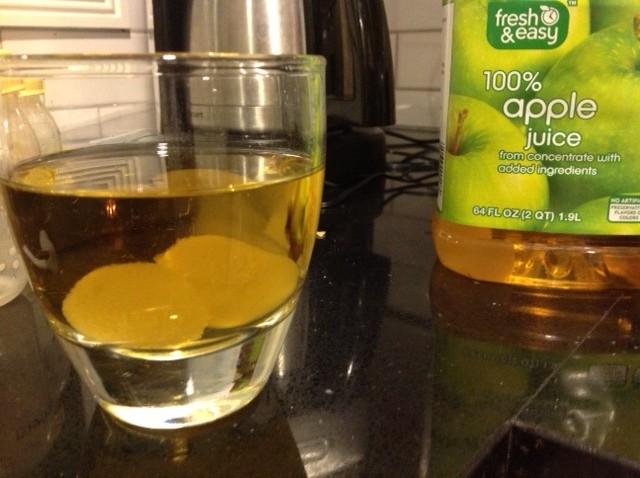 Two weeks ago, Erika posted about a new addition to our household — no, not our adorable children, but rather some viscous blobs lurking in menacing fashion at the bottom of a long-ignored bottle of apple juice.
Two weeks ago, Erika posted about a new addition to our household — no, not our adorable children, but rather some viscous blobs lurking in menacing fashion at the bottom of a long-ignored bottle of apple juice.
Said juice jug was purchased in early April, 2012. It was offered to guests, who declined. The bottle sat unopened in a dark, room-temperature pantry until mid-December, when we again offered it to guests. They too declined, but the thing was in the refrigerator by that time and taking up valuable space. In desperation I started trying to consume it myself. But we’re not a big juice house, and it was nearly two months more before Erika discovered the blobs.
What were they? The comments on Erika’s original post are well worth a gander — they’re a classic instance of the general principle that LWON’s readers are more insightful, resourceful and eloquent than LWON’s writers. The comments include hard information, informed speculation, personal anecdotes, suggestions for further investigation, and even a solid citation.

When Erika showed me the blobs, I was initially confused — I’d never seen anything quite like them in a food product. A moment later though, I was transported back to the sights and sounds of my hometown sewage treatment plant, and some particularly foul-smelling culture columns I worked with for a few weeks during an ill-advised master’s degree attempt in microbial ecology. Thanks to a tip in Erika’s comments and a little reading, it’s clear to me that the juice and the sewage samples were host to the same phenomenon: SCOBYs, or symbiotic colonies of bacteria and yeast. (Producers of vinegar call them “mothers” or “mother of vinegar”; producers of kefir and other even less palatable fermented drinks seem to have another 100 names for them. “Balm of Gilead,” anyone?)
Whenever you see massively globular colonies like these, it’s a safe bet that you’ve got a microbe secreting great clumps of polysaccharide mucous to control and manage a tricky environment. It’s the same general kind of stuff that many microbes use to stick to surfaces — like the dextrans that help oral bacteria form dental plaques, and the xantham gum that helps your store-bought salad dressing to flow when you shake and pour it, and then firm up and stick to the lettuce when it’s still.
But apple juice and sewage slurry are different: in those liquid environments, you’re not worried about sticking to surfaces so much as you’re trying to avoid the deadly effects of too much sugar and acid (the juice) or too much sulphur and the wrong amount of oxygen (the sewage). The great globs of mucopolysaccharide are usually produced by one microorganism and but used by several; in fact, they typically represent stable communities of microbes living together. The gooey matrix sets up environmental gradients between the center and the outside, with increasing levels of oxygen, say, or decreasing acidity as you move from the core to the surface of the blob. Each organism settles into its particular environmental comfort zone, and gets to work, I dunno, reducing sulphur in the absence of oxygen or whatever its thing is. And the beauty of the setup is that one organism’s waste products can become the next layer’s raw materials.
Or at least, that’s what I remember from the very early 1990s. I’d just finished an undergrad degree (bachelor of science in agriculture, since you ask) with a major in applied microbiology and food science. I was unnaturally obsessed with microbial decomposition of tricky molecules — the woody parts of plants, persistent herbicides, stuff like that — and for a while I thought I’d like to tease apart the chemistry and environmental conditions connecting each layer in SCOBYs from a sewage treatment plant. Until I realized that the work would be almost as impossible as my adviser at the time, and that the sulphurous odour of the things lingered with me for days.
I really hadn’t thought about these fascinating snot ball since. And now I wish I’d thought about them a little more. My one regret in all of this? After documenting the gross morphology of our juice globules with a couple of snapshots, I decanted the whole mess straight down the drain.
Commenter Lisa suggested sending the blobs off to a testing laboratory for diagnosis, and Doc John and Hannah both encourage closer inspection and experimentation — and making our own apple cider vinegar. Alas, such investigations have been rendered impossible by the food safety equivalent of archaeological treasure hunting. In my haste to secure the gaudy wealth of open fridge space, I foolishly destroyed something much more valuable: knowledge. Obviously, there’s only one thing to do … I’m off to the store to find a new bottle of apple juice to neglect.
__
Images Top: Little Audrey the skipping vinegar girl, Melbourne, Australia. Flickr user Leni McPoopies. Below: The blobs. Me.
SCOBYs! Who knew? Thanks for an interesting read.
i wonder if i am getting SCOBYs in my dyes – analine dye mixed with water and some vinegar, used to dye pysanky (ukrainian easter eggs? the dye is made fresh, used for a dozen or two eggs, put aside in a closed glassed jar, and a year later, it will have a gelatinous blob in it…
I-)